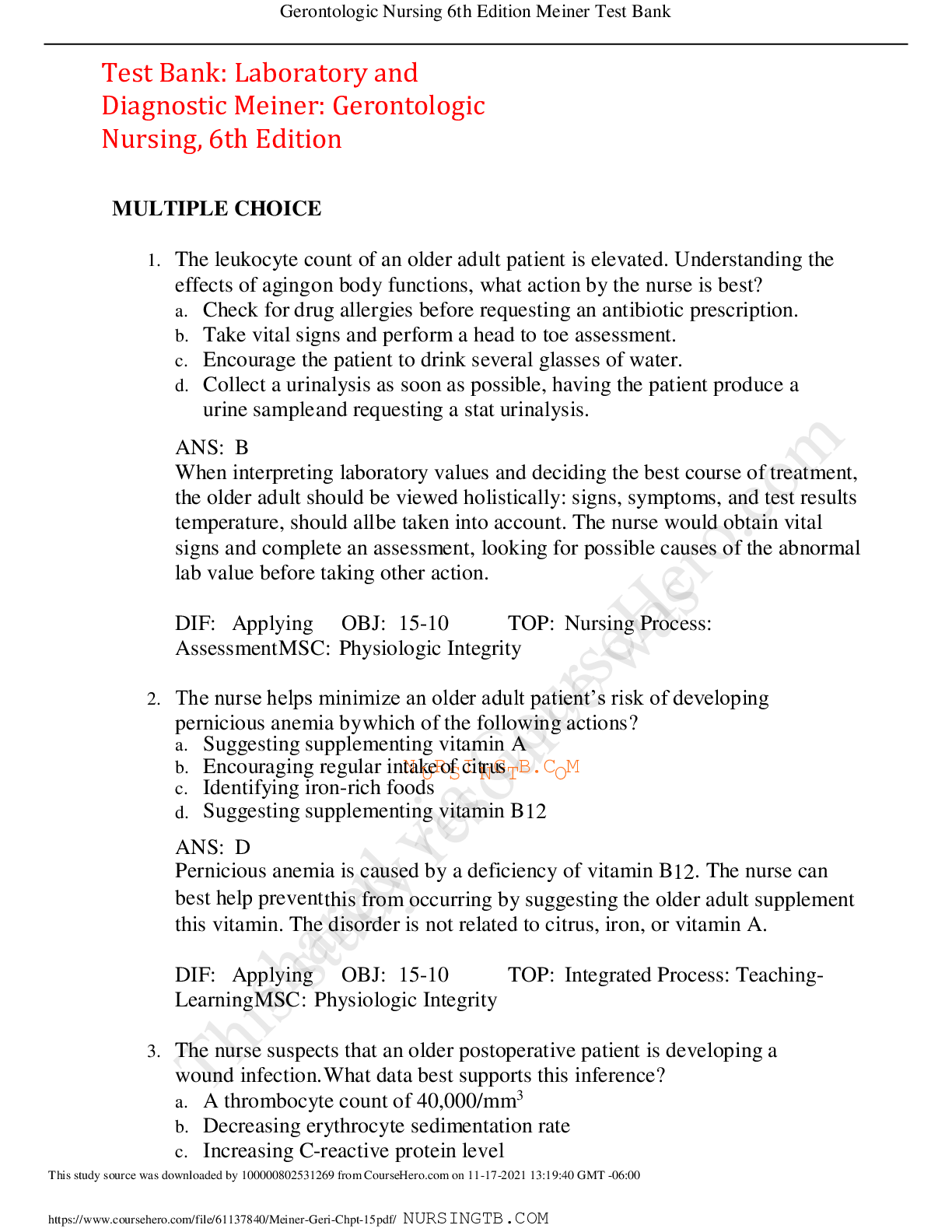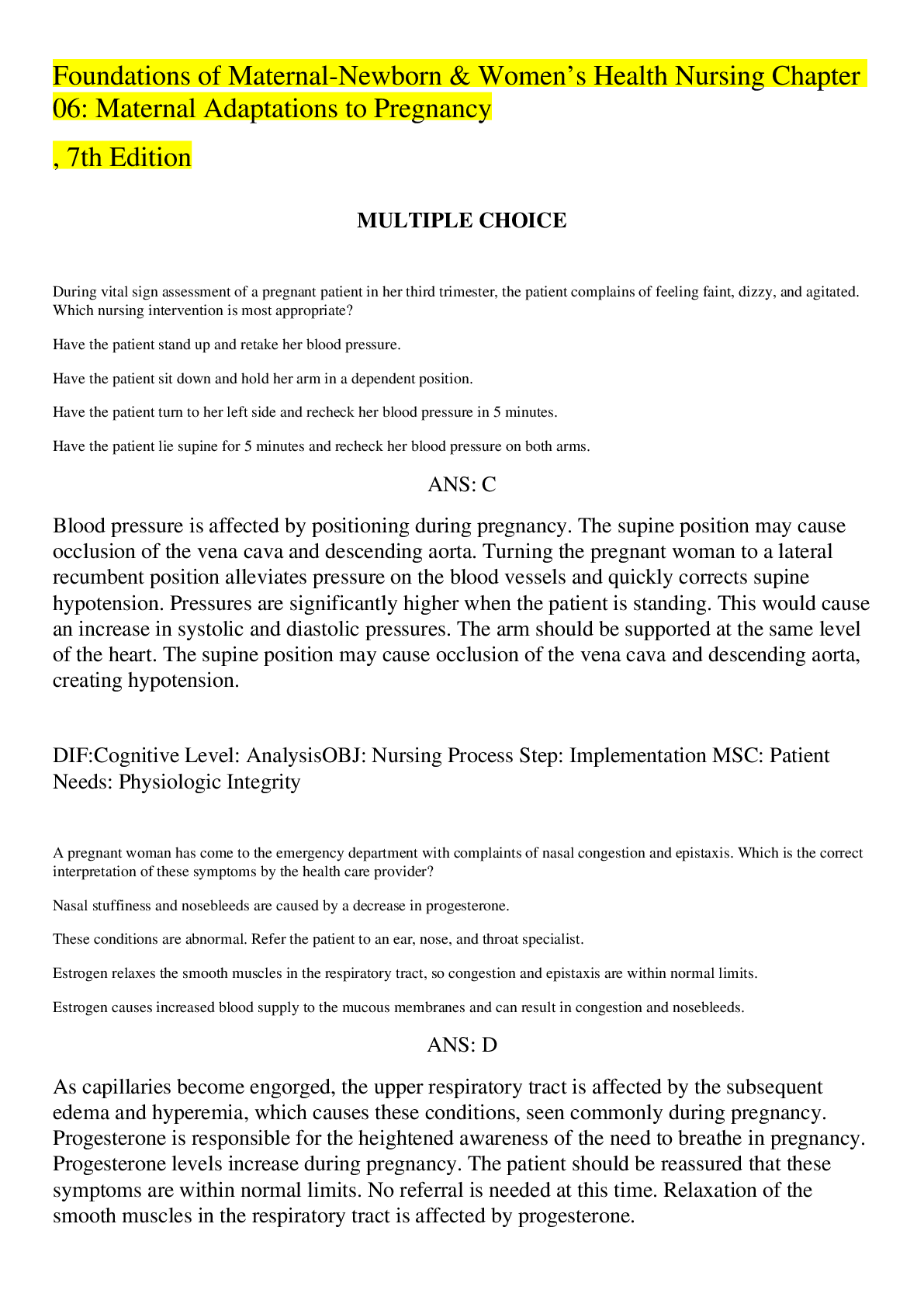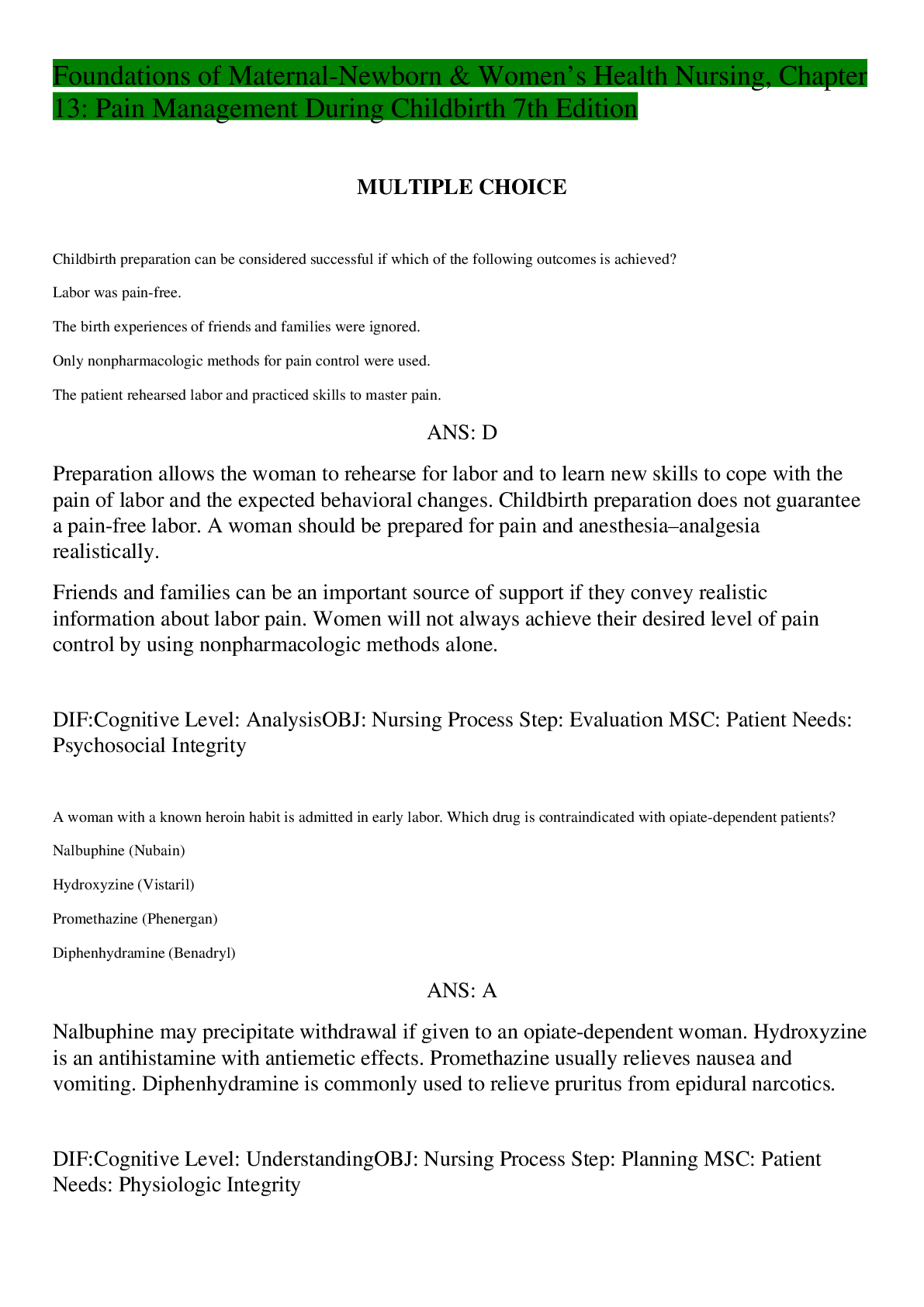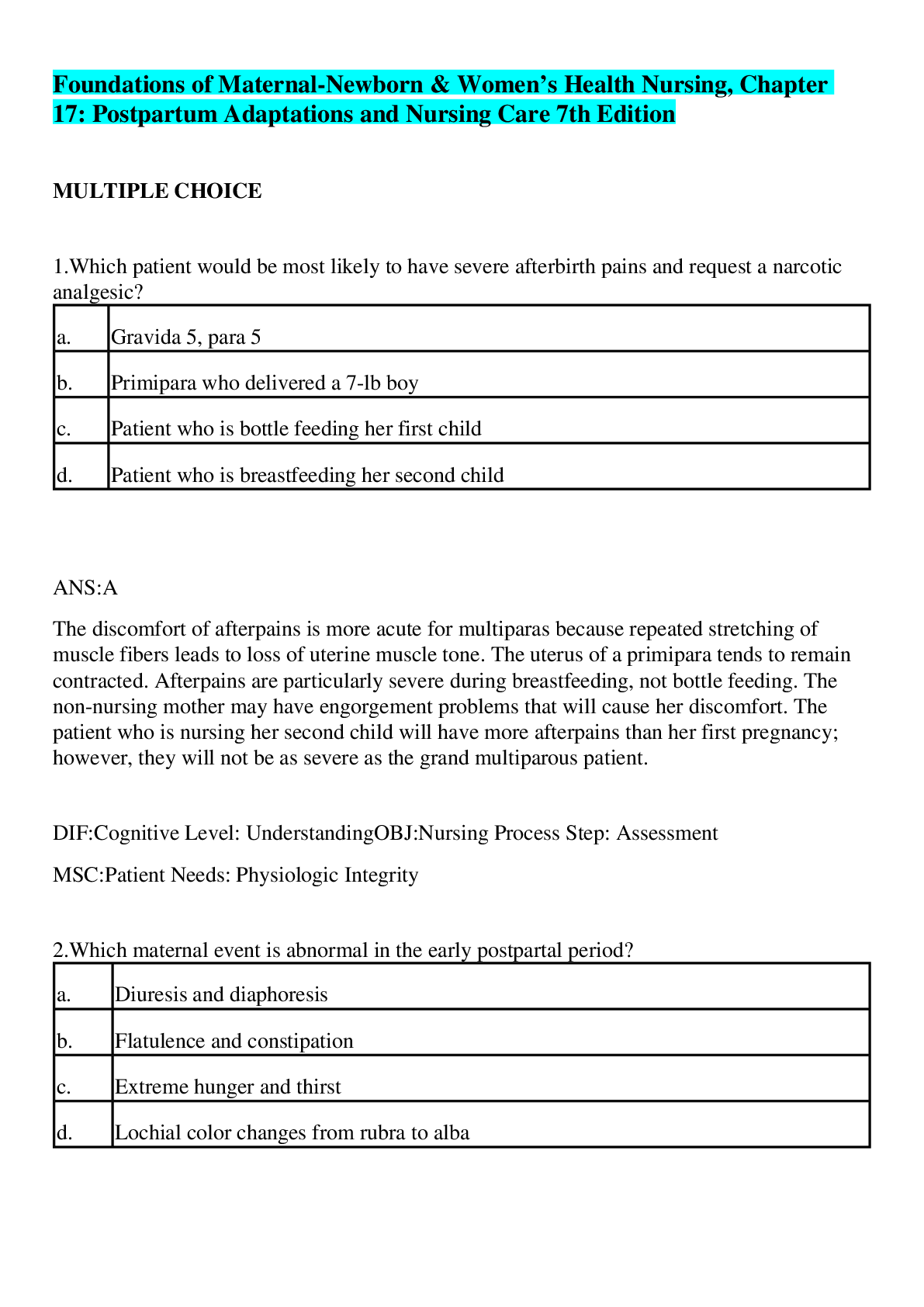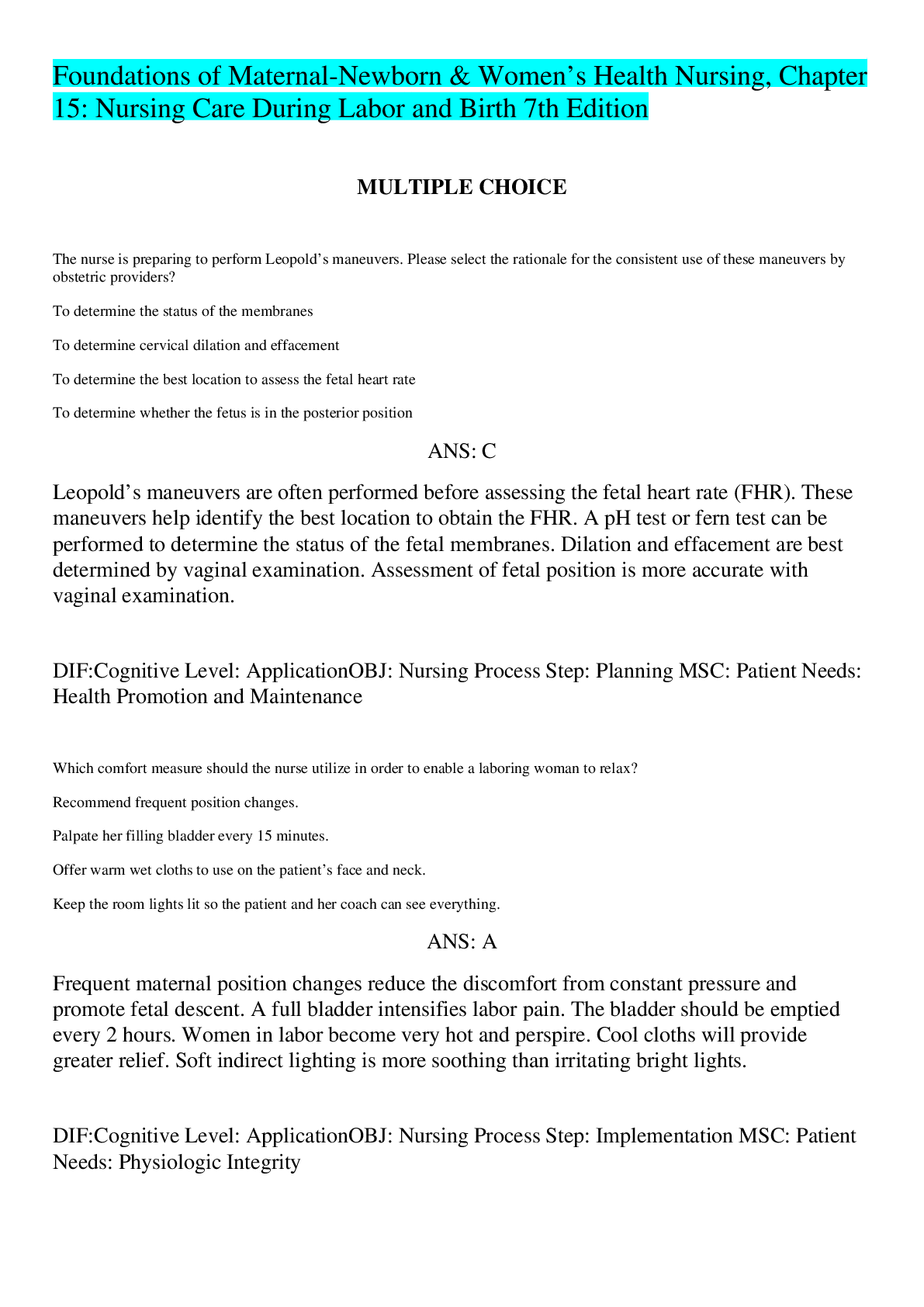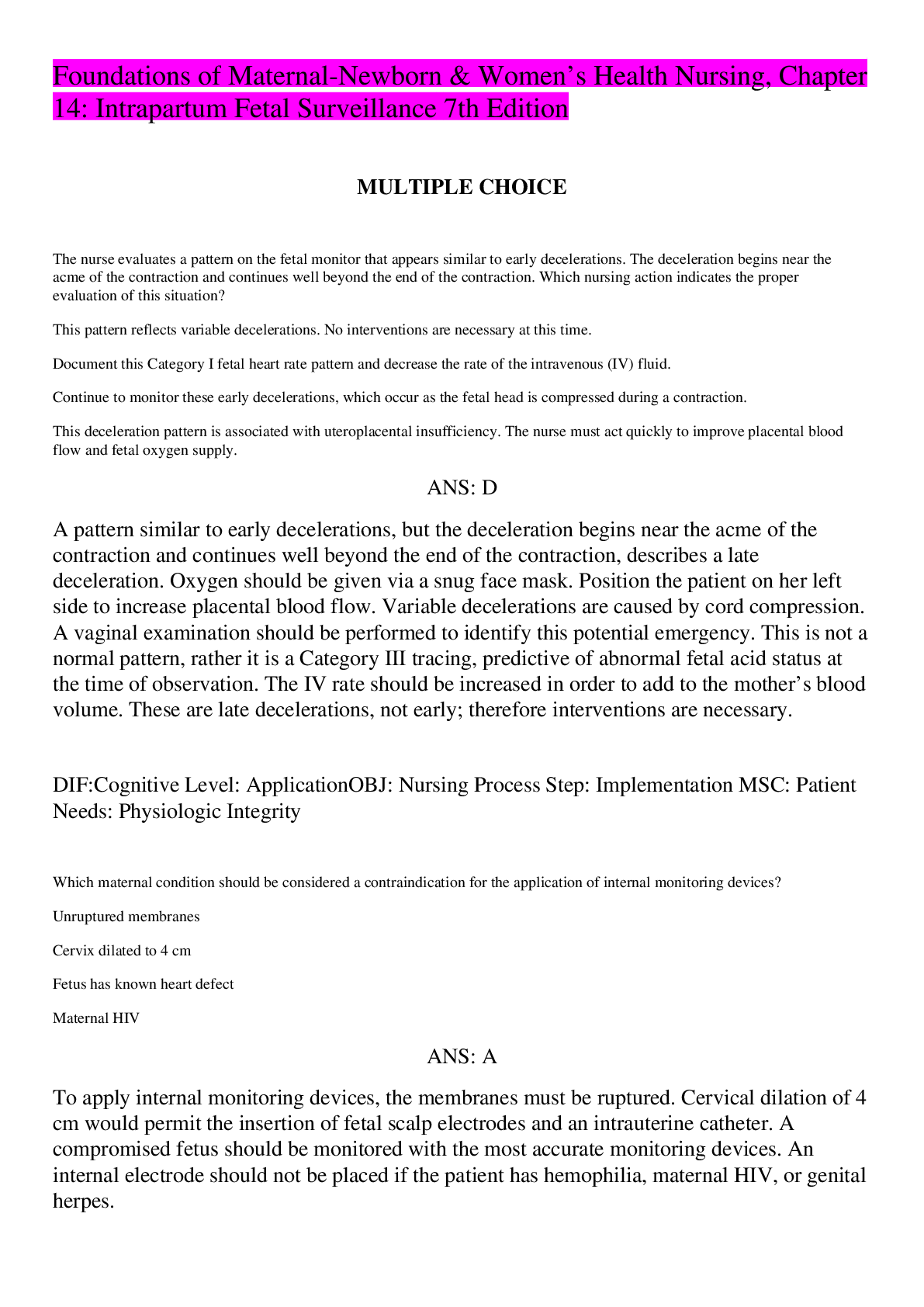*NURSING > TEST BANK > Test Bank: Alterations in Immunity Huether: Understanding Pathophysiology, 7th Edition,100% CORRECT (All)
Test Bank: Alterations in Immunity Huether: Understanding Pathophysiology, 7th Edition,100% CORRECT
Document Content and Description Below
Test Bank: Alterations in Immunity Huether: Understanding Pathophysiology, 7th Edition MULTIPLE CHOICE 1. When a patient asks the nurse what hypersensitivity is, how should the nurse respond? ... Hypersensitivity is best defined as: a. a reduced immune response found in most pathologic states. b. a normal immune response to an infectious agent. c. an excessive or inappropriate response of the immune system to a sensitizing antigen. d. antigenic desensitization. ANS: C Hypersensitivity is an altered immunologic response to an antigen that results in disease or damage to the individual. It is not a reduced immune response or a response to an infectious agent. Antigenic desensitization is performed to decrease hypersensitivity. 2. When the maternal immune system becomes sensitized against antigens expressed by the fetus, what type of immune reaction occurs? a. Autoimmune b. Anaphylaxis c. Alloimmune d. Allergic ANS: C Alloimmunity can be observeNdUdRurSinIgNimGmKIunNoGlo.gCicOreMactions against transfusions, transplanted tissue, or the fetus during pregnancy. Autoimmunity is a disturbance in the immunologic tolerance of self-antigens. The most rapid and severe immediate hypersensitivity reaction is anaphylaxis. An allergic response occurs related to exposure to an allergen. 3. A patient presents with poison ivy on the extremities, face, and buttocks after an initial exposure 48 hours ago. This condition is an example of: a. anaphylaxis. b. serum sickness. c. delayed hypersensitivity. d. viral disease. ANS: C The response to poison ivy is a delayed hypersensitivity because it takes up to 72 hours to develop. Anaphylaxis is immediate. Serum sickness-type reactions are caused by the formation of immune complexes in the blood and their subsequent generalized deposition in target tissues. Poison ivy is not a viral disease. 4. A 10-year-old male is stung by a bee while playing in the yard. He begins itching and develops pain, swelling, redness, and respiratory difficulties. He is suffering from: a. immunodeficiency. b. autoimmunity. c. anaphylaxis. d. tissue-specific hypersensitivity. ANS: C Anaphylaxis occurs within minutes of reexposure to the antigen and can be either systemic (generalized) or cutaneous (localized). Immunodeficiency is a decrease in the immune response. Autoimmunity is a disturbance in the immunologic tolerance of self-antigens. Tissue-specific reaction is an autoimmune reaction. 5. When a patient presents at the emergency department for an allergic reaction, the nurse recognizes the most severe consequence of a type I hypersensitivity reaction is: a. urticaria. b. hives. c. anaphylaxis. d. antibody-dependent cell-mediated cytotoxicity (ADCC). ANS: C The most rapid and severe immediate hypersensitivity type I reaction is anaphylaxis. Urticaria, or hives, is a dermal (skin) manifestation of allergic reactions. Hives and urticaria are similar responses. ADCC is a mechanism that involves natural killer (NK) cells. Antibodies on the target cell are recognized by Fc receptors on the NK cells, which release toxic substances that destroy the target cell. 6. Which information would indicate more teaching is needed regarding hypersensitivity reactions? Type hypersensitivity reactions involve an antibody response. a. I b. II c. III d. IV ANS: D NURSINGKING.COM Type IV reactions are mediated by T lymphocytes and do not involve antibodies. All the remaining options are associated with antibody responses. 7. A 30-year-old male is having difficulty breathing and has been spitting blood. He reports that he began experiencing this reaction after cleaning his pigeons’ cages. Testing reveals he is suffering from allergic alveolitis. Which of the following is he experiencing? a. Serum sickness b. Raynaud phenomenon c. Antibody-dependent cytotoxicity d. Arthus reaction ANS: D The Arthus reaction is a model of localized or cutaneous reactions. Serum sickness-type reactions are caused by the formation of immune complexes in the blood and their subsequent generalized deposition in target tissues. Typically affected tissues are the blood vessels, joints, and kidneys. Raynaud phenomenon is a condition caused by the temperature-dependent deposition of immune complexes in the capillary beds of the peripheral circulation. Antibody-dependent cytotoxicity is a type II form. 8. A nurse recalls that an example of an immune-complex-mediated disease is: a. bronchial asthma. b. contact dermatitis. c. serum sickness. d. rheumatoid arthritis. ANS: C Immune-complex disease can be a systemic reaction, such as serum sickness, and related to type III reactions. Bronchial asthma is not an immune-complex-mediated disease and is related to type I reactions. Neither contact dermatitis nor rheumatoid arthritis is related to type III reactions. 9. When a nurse cares for a patient with systemic lupus erythematosus (SLE), the nurse remembers this disease is an example of: a. autoimmunity. b. alloimmunity. c. homoimmunity. d. alleimmunity. ANS: A SLE is the most common, complex, and serious of the autoimmune disorders. SLE is not identified as alloimmune, homoimmune, or alleimmune. 10. A 30-year-old female complains of fatigue, arthritis, rash, and changes in urine color. Laboratory testing reveals anemia, lymphopenia, and kidney inflammation. Assuming a diagnosis of SLE, which of the following is also likely to be present? a. Anti-LE antibodies b. Autoantibodies c. Antiherpes antibodies d. Anti-CMV antibodies ANS: B NURSINGKING.COM The presence of autoantibodies is a diagnostic criterion for SLE. Diagnostic criterion for SLE would include positive LE. Neither antiherpes nor anti-CMV antibodies are associated with a diagnosis SLE. 11. A 40-year-old female is diagnosed with SLE. Which of the following findings would be considered a symptom of this disease? a. Gastrointestinal ulcers b. Decreased glomerular filtration rate c. Rash on trunk and extremities d. Photosensitivity ANS: D Photosensitivity is one of the 11 common clinical findings in SLE. Gastrointestinal ulcers are not a finding in SLE. Proteinuria is a symptom of SLE. A rash on the face is a symptom, but not a rash on the body. 12. What is the chance that two siblings share both HLA haplotypes, making them a good match for an organ transplant from one to the other? a. 100% b. 75% c. 50% d. 25% ANS: D Odds dictate that children will share one haplotype with half their siblings and either no haplotypes or both haplotypes with a quarter of their siblings. Thus, the chance of finding a match among siblings is much higher (25%) than the general population. 13. When a nurse notices that a patient has type O blood, the nurse realizes that anti- antibodies are present in the patient’s body. a. A only b. B only c. A and B d. O ANS: C Type O individuals have both anti-A and anti-B antibodies but not O. 14. In addition to matching ABO antigens, a blood transfusion must also be matched for: a. HLA type. b. Rh antigen. c. immunoglobulins. d. platelet compatibility. ANS: B Blood transfusions must also be matched for the Rh antigen. Blood transfusions do not need to be matched to HLA, immunoglobulins, or platelet compatibility. 15. A 15-year-old male suffers from severe hemorrhage following a motor vehicle accident. He is given a blood transfusion, but shortly afterward the red blood cells are destroyed by agglutination and lysis. WhicNh UofRtSheIfNoGlloKwIinNgGb.loCoOdMtype transfusion type matches would cause this? a. A-A b. B-O c. AB-O d. A-AB ANS: D A person with type A blood also has circulating antibodies to the B carbohydrate antigen. If this person receives blood from a type AB or B individual, a severe transfusion reaction occurs, and the transfused erythrocytes are destroyed by agglutination or complement-mediated lysis. Type A can receive type A blood. Type B and type AB can receive type O. 16. A person is given an attenuated antigen as a vaccine. When the person asks what was given in the vaccine, how should the nurse respond? The antigen is: a. alive, but less infectious. b. mutated, but highly infectious. c. normal, but not infectious. d. inactive, but infectious. ANS: A Attenuated vaccines are alive, but less infectious. Attenuated vaccines are not mutated or highly infectious. Inactive infers the virus is killed. 17. A 5-year-old male presents with low-set ears, a fish-shaped mouth, and involuntary rapid muscular contraction. Laboratory testing reveals decreased calcium levels. Which of the following diagnosis is most likely? a. B-lymphocyte deficiency b. T-lymphocyte deficiency c. Combined immunologic deficiency d. Complement deficiency ANS: B DiGeorge syndrome results in greatly decreased T cell numbers and function and is evidenced by abnormal development of facial features that are controlled by the same embryonic pouches; these include low-set ears, fish-shaped mouth, and other altered features. B-lymphocyte deficiency is not manifested by these symptoms. Neither combined immunologic deficiency nor complement deficiency is manifested by these symptoms. 18. A 22 year old was recently diagnosed with acquired immunodeficiency syndrome (AIDS). Which decreased lab finding would be expected to accompany this virus? a. CD4+ T-helper b. CD8 T-helper c. CDC cells d. CDC10 cells ANS: A The major immunologic finding in AIDS is the striking decrease in the number of CD4+ T-helper cells. The change occurs in CD4 cells, not CD8. Neither CDC nor CDC 10 is a type of cell. 19. Which of the following is a cNhaUraRcSteIriNstGicKoIf tNhGe .huCmOaMn immunodeficiency virus (HIV), which causes AIDS? a. HIV only infects B cells. b. HIV is a retrovirus. c. Infection does not require a host cell receptor. d. After infection, cell death is immediate. ANS: B AIDS is an acquired dysfunction of the immune system caused by a retrovirus (HIV) that infects and destroys CD4+ lymphocytes (T-helper cells). HIV infection begins when a virion binds to CD4, not a B cell. Infection requires a host cell receptor. The cell remains dormant but does not die. 20. A 30-year-old male was diagnosed with HIV. Which of the following treatments would be most effective? a. Reverse transcriptase inhibitors b. Protease inhibitors c. Entrance inhibitors d. Antiretroviral therapy (ART) ANS: D The current regimen for treatment of HIV infection is a combination of drugs, termed antiretroviral therapy (ART). The remaining options are individual components of the ART treatment format. 21. The nurse would correctly respond that the etiology of a congenital immune deficiency is due to a(n): a. negative response to an immunization. b. adverse response to a medication. c. renal failure. d. genetic defect. ANS: D A primary (congenital) immune deficiency is caused by a genetic defect. A primary (congenital) immune deficiency is not a response to an immunization, an adverse response to a medication, or due to renal failure. 22. An infant is experiencing hemolytic disease of the newborn. Which of the following would the nurse expect to find in the infant’s history and physical? a. The mother was exposed to measles. b. The father was exposed to Agent Orange. c. The baby is Rh positive. d. The baby was born 6 weeks prematurely. ANS: C Hemolytic disease of the newborn was most commonly caused by IgG anti-D alloantibody produced by Rh-negative mothers against erythrocytes of their Rh-positive fetuses. This disorder is not due to the mother’s exposure to measles, the father’s exposure to Agent Orange, or the baby’s prematurity. MULTIPLE RESPONSE NURSINGKING.COM 1. A 30-year-old female is diagnosed with systemic lupus erythematosus (SLE). Which symptoms are a result of a type II hypersensitivity? (Select all that apply.) a. Anemia b. Seizures c. Lymphopenia d. Facial rash e. Photosensitivity ANS: A, C The patient is experiencing type II hypersensitivity when experiencing anemia and lymphopenia. Seizures, facial rash, and photosensitivity are not associated with type II hypersensitivity reactions. [Show More]
Last updated: 1 year ago
Preview 1 out of 11 pages
Instant download

Buy this document to get the full access instantly
Instant Download Access after purchase
Add to cartInstant download
Reviews( 0 )
Document information
Connected school, study & course
About the document
Uploaded On
Nov 06, 2021
Number of pages
11
Written in
Additional information
This document has been written for:
Uploaded
Nov 06, 2021
Downloads
0
Views
53










